Recent Posts
Oak Cliff Project
1/17/2025 (Permalink)
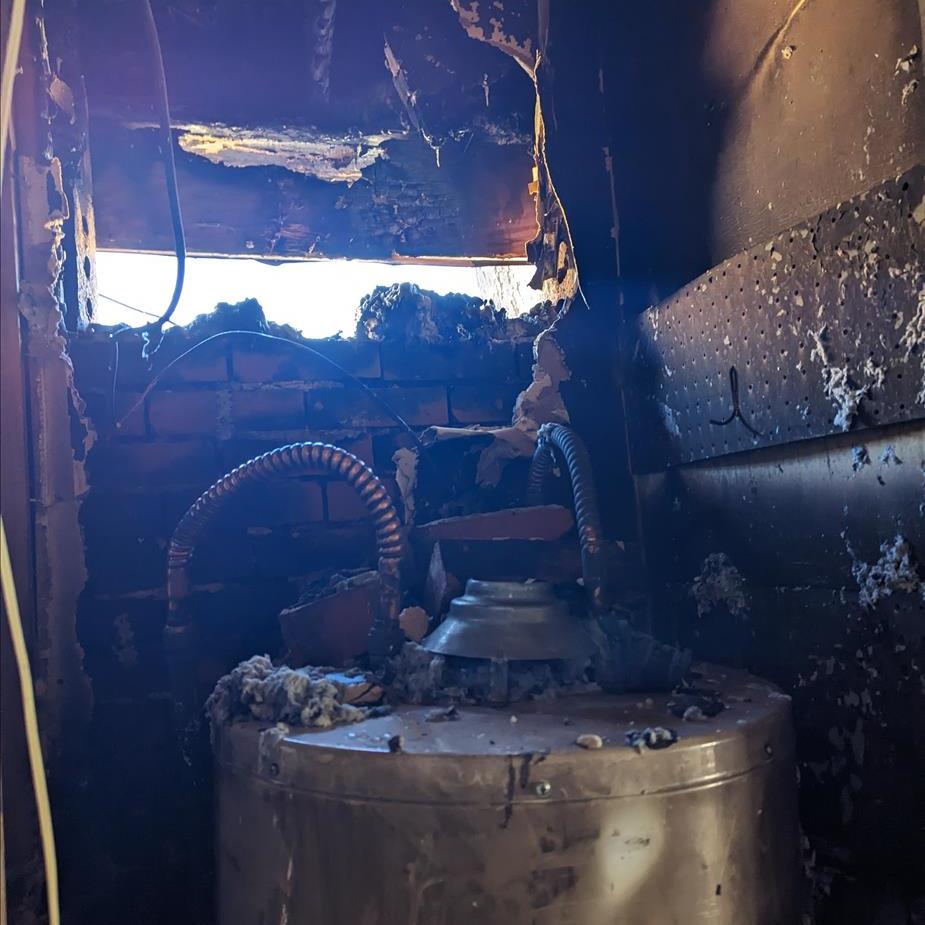 Remnants of an Oak Cliff Fire
Remnants of an Oak Cliff Fire
Our team is always ready to help when fire or water damages occur. Trained technicians sprung to action when a fire occurred at a local Oak Cliff business, and we are always happy to help our neighbors, even in unfortunate circumstances. Sometimes when a fire occurs, the water damage is just as devastating as the fire damages. It is important to have the right team in place to take care of both. Ozone treatments, demolition, thermal fogging, chemical cleaning, etc., is needed to take care of the odor. Also, proper drying of materials, spraying with antimicrobial fungicide, and the use of moisture meters is necessary to make sure growth does not occur. Sometimes sealing of the affected areas is also necessary, but only when a trained professional has deemed that it is the correct time so as to not seal in moisture or odors that may later escape the materials. Hopefully you never have to deal with this type of situation, but if you do, make sure to get the right team to help you out.
Oak Cliff New Builds
10/21/2024 (Permalink)
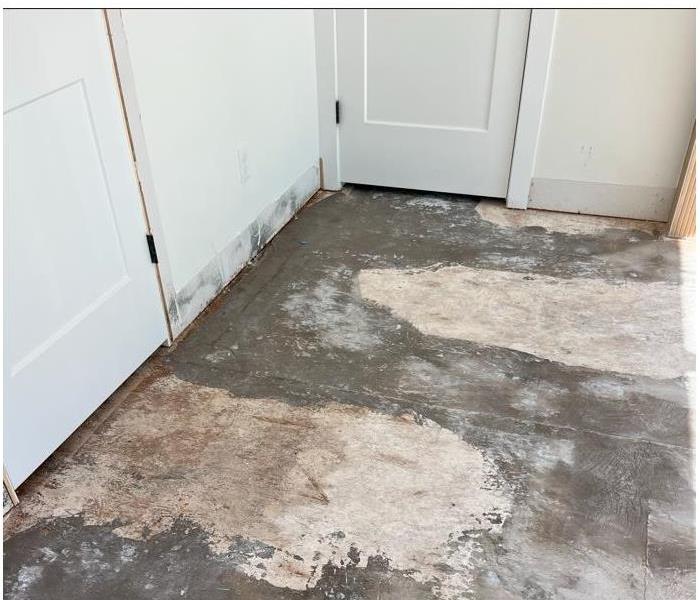 Water damage causing growth.
Water damage causing growth.
The explosion of new home building in the Oak Cliff community has caused an increase in calls due to broken pipes and leaks occurring during the new build process. When water damage occurs it is imperative that our team is on the scene as soon as possible to dry out the area, remove necessary materials, and keep the possibility of mold to a minimum. However, if potential mold is discovered, we can help take care of that too. Time is of the essence, better safe than sorry.
Suspected Leak
7/18/2024 (Permalink)
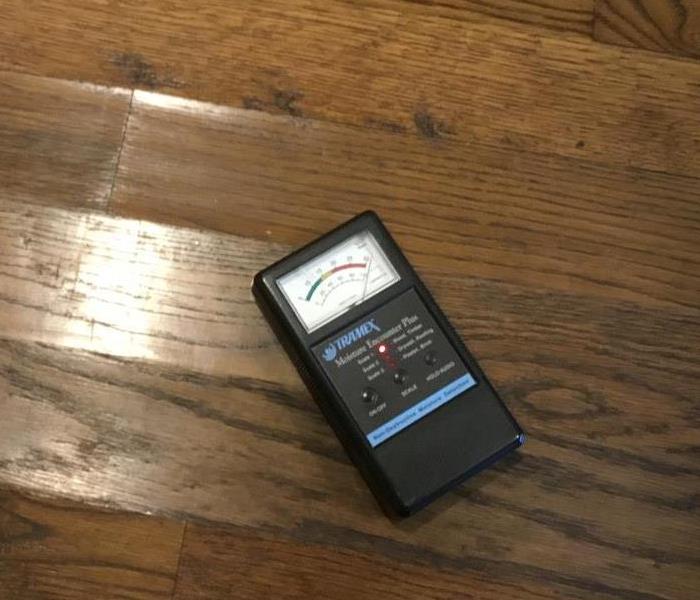 Moisture meter on affected wood flooring.
Moisture meter on affected wood flooring.
Sometimes we find that homeowners suspect that they have a leak, but are unsure of the cause and/or the extent of the water damages. Our trained technicians use thermal cameras and moisture meters to help try and pinpoint the source of the leak, as well as determine the extent of the damages. For example, drywall may look "dry", but the thermal camera and moisture meters can determine if there is excess moisture in an area. Some telltale signs of a leak may be cupping floors or baseboards separating from the walls. If it is determined that there is water damage, our team can place some drying equipment to help keep things stabilized until the leak is fixed and the area can be effectively dried.
What Does Crime Scene Clean Up Mean?
4/9/2024 (Permalink)
 A large swath of blood on a concrete floor in a commercial building
A large swath of blood on a concrete floor in a commercial building
Most of the time, a crime scene will involve clean up of blood but it can be other biological material as well. If a person is not found within a couple days of passing away their body will start breaking down resulting in other fluids being released. The clean up will also typically involve mitigating the odor that comes along with the decomposition. Unaffected, porous materials like clothing will need to be discarded in order removed the odor. Additionally, crime scene clean up often includes doing necessary demolition to the property to make sure all the biological material is removed. It is typically the case that the body has been removed before the crime scene cleaner arrives on the scene. Cleanable hard items like glass or metal will need to be sanitized and disinfected. Give our SERVPRO of Southwest Dallas team a call if you need some assistance with crime scene cleaning.
How to Drive Safely in Snow
1/2/2024 (Permalink)
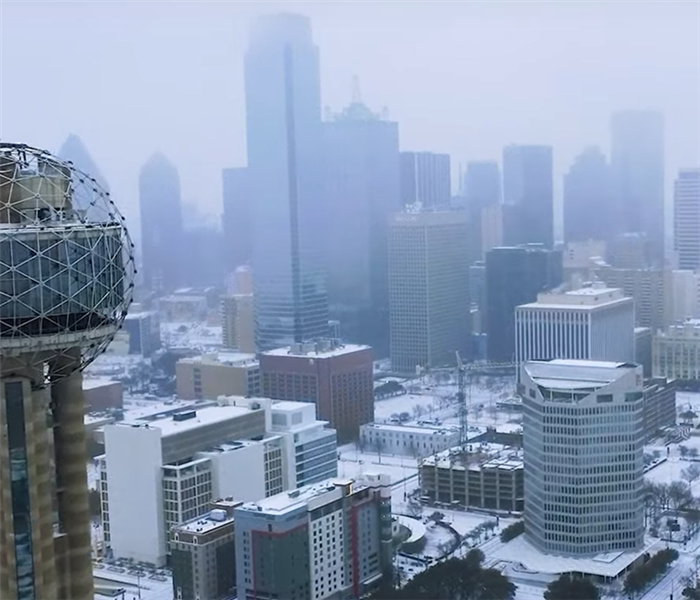 Snow covering streets & buildings in Downtown Dallas
Snow covering streets & buildings in Downtown Dallas
Snow-covered landscapes hold a certain magic, but they also present unique challenges for drivers. Fear not, winter warriors! Navigating snowy roads doesn't have to be a white-knuckle experience. With a little preparation and some key driving tips, you can conquer the white road and reach your destination safely.
Before You Hit the Road:
Gear Up: Equip your car for winter conditions. Swap out your regular tires for snow tires or all-weather tires with a good tread depth. Check your tire pressure regularly, as cold temperatures can cause it to drop. Ensure your windshield wiper fluid is topped up with a winter-grade mixture to combat freezing temperatures.
Pack Smart: Prepare an emergency kit for your car, including a shovel, jumper cables, flares, a first-aid kit, blankets, non-perishable food, and bottled water. A portable phone charger can be a lifesaver too.
Plan Your Route: Choose main roads that are more likely to be plowed and sanded. Check traffic reports and weather updates before you leave to avoid potential trouble spots.
Hitting the White Stuff:
Slow Down: The golden rule of snow driving is to adjust your speed. Roads become slippery, and stopping distances increase significantly. Take it slow and steady, even if the roads look clear. Remember, it's not a race to your destination.
Gentle Touches: Avoid jerky movements with the steering wheel, accelerator, and brakes. Sudden changes in direction or speed can cause you to lose control. Apply the gas and brakes smoothly and gradually.
Increase Following Distance: Leave plenty of space between your car and the vehicle ahead. Double or even triple the normal following distance to give yourself ample time to react and brake safely.
Pump the Brakes: If you don't have anti-lock brakes (ABS), don't slam on the brakes! Instead, pump them rapidly to prevent the wheels from locking up and skidding. ABS will do the pumping for you, so just apply firm and steady pressure.
Mind the Turns: Take corners slowly and wide. Avoid sharp turns that could send you into a skid. Ease off the gas as you approach a turn and maintain a steady speed while navigating the corner.
Beware Black Ice: This invisible enemy lurks on shaded roads and bridges, appearing deceptively like wet pavement. Be extra cautious in these areas and adjust your speed accordingly.
Turn On Your Lights: Even during the day, turn on your headlights to increase your visibility to other drivers. Fog lights can also be helpful in low-visibility conditions.
Stay Calm and Collected: Panicking behind the wheel is never helpful. If you do get into a skid, stay calm, ease off the gas and brakes, and steer gently in the direction you want to go. The car will eventually regain traction.
Bonus Tips:
- Avoid using cruise control in snowy conditions.
- Clear all snow and ice from your car before driving, including the roof, hood, and mirrors.
- Don't park your car on an incline, as it can be difficult to get started again.
- If you get stuck, stay with your car and call for help. Running the engine for short periods with the heater on can help you stay warm while you wait for assistance.
Remember, the key to safe winter driving is preparation, caution, and common sense. By following these tips and adapting your driving habits to the conditions, you can navigate the snowy roads with confidence and reach your destination safely. So buckle up, stay alert, and enjoy the winter wonderland!
Happy and safe winter driving!
Christmas Decoration Safety Tips
12/4/2023 (Permalink)
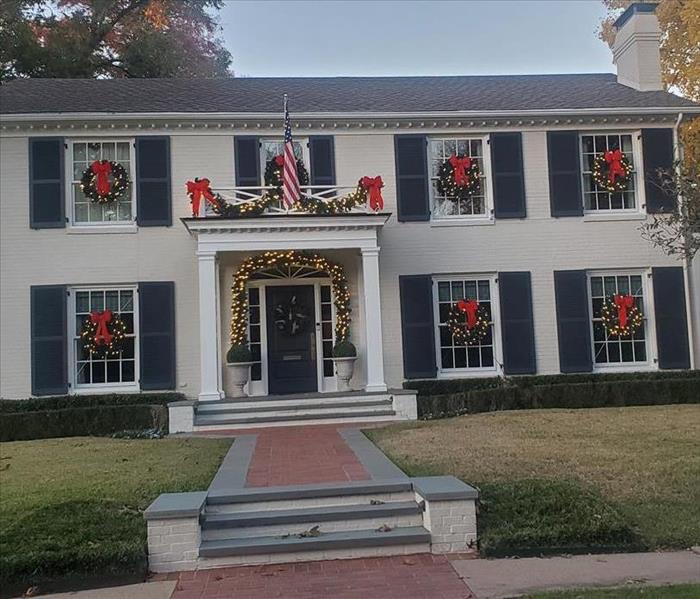 House with Christmas lights & decorations
House with Christmas lights & decorations
Decorating your home for the holidays is a fun and exciting way to get into the festive spirit. However, it’s important to keep safety in mind while doing so. Here are some tips to help you decorate your home safely for the holidays:
Inspect all holiday light cords: Before hanging up your lights, check all cords to ensure they aren’t frayed or broken. Damaged cords can cause electrical fires, so it’s important to replace them if necessary. You don't want to have to call in a professional fire mitigation company!
Don’t string too many strands of lights together: To avoid overloading your electrical outlets, don’t string more than three strands of lights together per extension cord.
Turn off all holiday lights when going to bed or leaving the house: This will help prevent electrical fires from occurring while you’re away.
Ensure outside decorations are for outdoor use: If you’re decorating the outside of your home, make sure that all decorations are designed for outdoor use. Additionally, fasten lights securely to your home or trees to prevent them from falling.
Look for the fire-resistant label when buying an artificial tree: If you’re buying an artificial tree, make sure it has a fire-resistant label. Keep it away from fireplaces, radiators, and other sources of heat.
Never use electric lights on metallic trees: Electric lights can cause metallic trees to become charged with electricity, which can be dangerous.
If getting a live tree, make sure it’s fresh and keep it watered: A dry tree can easily catch fire, so it’s important to keep it watered. Bend the needles up and down to make sure no needles fall off.
Don’t light the fireplace if hanging stockings on the mantel: Stockings can easily catch fire if they’re too close to an open flame.
Check the labels of older decorations: Some older tinsel is lead-based, which can be harmful if ingested.
If using angel hair, wear gloves to avoid irritation: Angel hair can be irritating to the skin, so it’s important to wear gloves when handling it.
Avoid breathing in artificial snow: Artificial snow can be harmful if inhaled, so it’s important to avoid breathing it in.
Have good, stable placement when using a ladder and wear shoes that allow for good traction: When hanging decorations, make sure your ladder is on a stable surface and wear shoes that allow for good traction to prevent falls.
Fall House Cleaning Tips
11/7/2023 (Permalink)
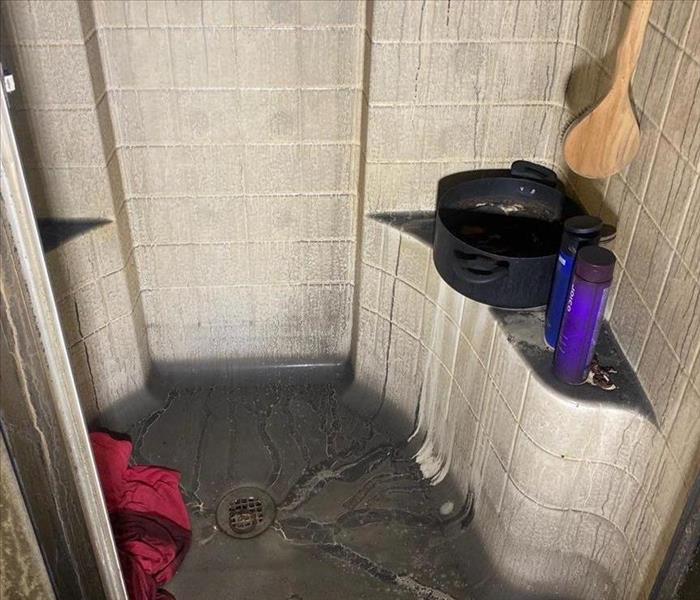 Shower covered in fire soot
Shower covered in fire soot
Fall House Cleanup
As the leaves start to change colors and the air becomes crisp, it’s time to start thinking about fall house cleaning. The end of summer is the perfect time to give your home a deep clean before the winter months of sitting inside are here. Here are some tips to help you get started:
Declutter
The first step in any fall house cleaning is to declutter. Go through each room in your home and get rid of anything that you no longer need or use. This will not only make your home look neater, but it will also make it easier to clean.
Clean the Gutters
Cleaning the gutters is an important part of fall house cleaning. Leaves and debris can accumulate in your gutters over the summer months, which can cause water damage to your home. Make sure to clean your gutters thoroughly to prevent any damage.
Deep Clean the Carpets
Fall is the perfect time to deep clean your carpets. Over the summer months, dirt and dust can accumulate in your carpets. Hire a professional carpet cleaner to deep clean your carpets and remove any dirt and dust.
Clean the Windows
Cleaning the windows is another important part of fall house cleaning. Over the summer months, dirt and dust can accumulate on your windows, which can make them look dirty and dull. Use a window cleaner to clean your windows and make them look like new.
Clean the Fireplace
Fall is the perfect time to start using your fireplace again. Before you start using it, make sure to clean it thoroughly. Remove any ash and debris from the fireplace and clean the chimney to prevent any fire hazards. If something does happen, call a professional fire mitigation company.
Clean the Kitchen
The kitchen is one of the most important rooms in your home, and it’s important to keep it clean. Clean your kitchen thoroughly, including the countertops, cabinets, and appliances. Make sure to remove any food that has expired or gone bad.
Clean the Bathroom
The bathroom is another important room in your home, and it’s important to keep it clean. Clean your bathroom thoroughly, including the sink, toilet, and shower. Make sure to remove any mold or mildew that has accumulated.
Conclusion
Fall house cleaning is an important part of maintaining your home. By following these tips, you can ensure that your home is clean and ready for the winter months. Remember to declutter, clean the gutters, deep clean the carpets, clean the windows, clean the fireplace, clean the kitchen, and clean the bathroom. Happy cleaning!
Halloween Safety Tips for 2023
10/23/2023 (Permalink)
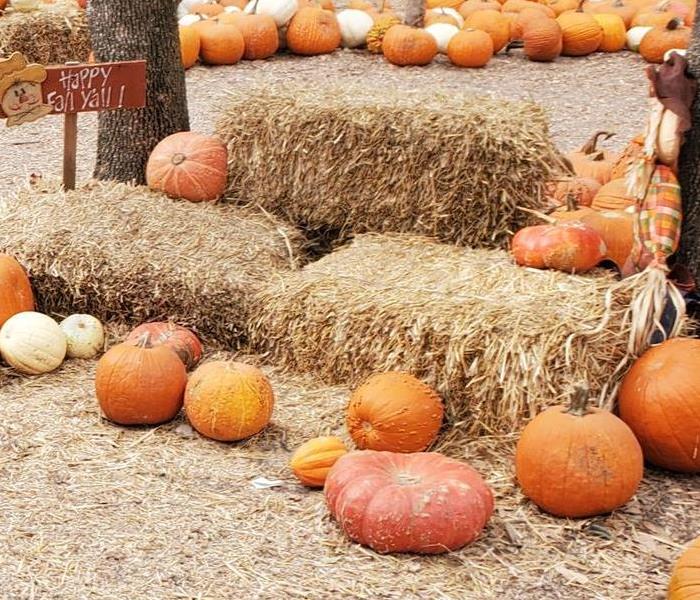 Pumpkin patch with hay and pumpkins
Pumpkin patch with hay and pumpkins
Halloween is a fun and exciting time of the year, but it’s important to keep safety in mind. Here are some tips to ensure that you and your loved ones have a safe and enjoyable Halloween:
Costume Safety: Choose costumes that are made of flame-resistant materials and are not too long to avoid tripping. If you’re wearing a mask, make sure it doesn’t obstruct your vision. Opt for nontoxic makeup instead of masks. Test the makeup on a small area of skin before applying it to your face to avoid any allergic reactions.
Trick-or-Treating Safety: Always accompany young children while trick-or-treating. If your older children are going alone, make sure they have a mobile phone and agree on a specific time for them to return home. Teach your children to walk on sidewalks or paths and cross the street at crosswalks or intersections. Make sure they carry a flashlight or glow stick and wear reflective clothing or tape.
Candy Safety: Inspect all candy before allowing your children to eat it. Discard any candy that is unwrapped, has torn packaging, or looks suspicious.
Home Safety: Keep your home well-lit and free of obstacles that could cause someone to trip. Use battery-operated candles instead of real candles in jack-o’-lanterns. We don't want to call a fire mitigation company!
Driving Safety: Be extra cautious while driving on Halloween night as there will be many pedestrians on the road. Slow down and watch out for children who may dart out into the street.
These tips will help you have a safe and enjoyable Halloween with your loved ones!
What is a Deductible on an Insurance Claim?
8/22/2023 (Permalink)
 Lakewood house with water in walls and buckling floors from a faulty water heater
Lakewood house with water in walls and buckling floors from a faulty water heater
Home Insurance in Texas
In Texas, homeowners are not required to have Home Insurance but if you have a mortgage on your home, your mortgage company may require it. Though it is not required, it is heavily recommended.
What is a Deductible?
The most common reasons for a home insurance claim are wind and hail damage, water and freezing damage, fire damage, and theft. Home insurance is typically paid on a monthly basis and often for years before it is needed. Deductibles can be a flat amount or a percent of the home value. This can often range between $500-$2,000 or 1-2%. The insured will pay the deductible amount, with the insurance company usually covering everything above and beyond that amount. For example, the average fire damage claim is around $80,000. If the deductible was $2,000, the insured would pay that amount with the remaining $78,000 being paid by the insurance company.
When to Make an Insurance Claim
When an issue arises that may cause the need for water damage mitigation or fire damage restoration services, it is worth determining the cost to fix the issue before making an insurance claim. Using the example mentioned above, if the cost to take care of the problem is below the deductible, a claim should not be made. Often if the cost is slightly above the deductible, it may not be worth making a claim. Calling insurance to make a claim and not actually following through with the claim can cause what is known as a zero-dollar claim. Though the homeowner did not officially get any monetary benefit from the insurance company, it is now on their record and typically results in an increase in the monthly insurance rates going forward.
Who to Call for Help?
A call to a professional mitigation/restoration company like the experts at SERVPRO of Southwest Dallas. They can assist in surveying the damage, coming up with a plan and an estimate to help with your claim decision.
What Causes the Most Damage in a Fire?
6/20/2023 (Permalink)
 Soot Damage to Furniture in a Dallas apartment fire
Soot Damage to Furniture in a Dallas apartment fire
When a fire occurs in a building or home, we naturally think of items getting burned up and the structure being charred and compromised. Fire response times are usually very good these days for a variety of reasons namely technology. Most fires are able to be put out in a reasonable amount of time before serious structural damage has occurred. Most often, the fire damage is due to water and soot.
Water can first enter the fray from sprinkler systems, drowning whole room or rooms in water. However, the main source of water stems from Fire Fighters spraying down many rooms while punching holes in the ceiling.
Once the fire is put out, the entirety of the damage can be observed. The heat of the fire causes soot particles to rise and float around the structure. In most fires, you will find the most blackened areas to be at the source and on the ceiling. The soot will eventually settle on items all around the building with the assistance of the HVAC system. Which brings into play another issue, the HVAC system can be thoroughly covered and will need cleaned if not replaced.
Depending on the fire, soot can be greasy and hard to clean. When it comes to fire damage restoration of contents, they can typically be divided into 2 groups, porous and non-porous. Non-porous are more hard surface items like glass, metal and wood. These can usually be cleaned with specific soot solutions. Porous items like clothes and fabric on furniture is more challenging to clean. With special chemicals and processes, there can be a pretty good success rate but there still will be some unsalvageable items.
If you need assistance getting back to normal after a fire, please give us a call, we are here to help!






 24/7 Emergency Service
24/7 Emergency Service








